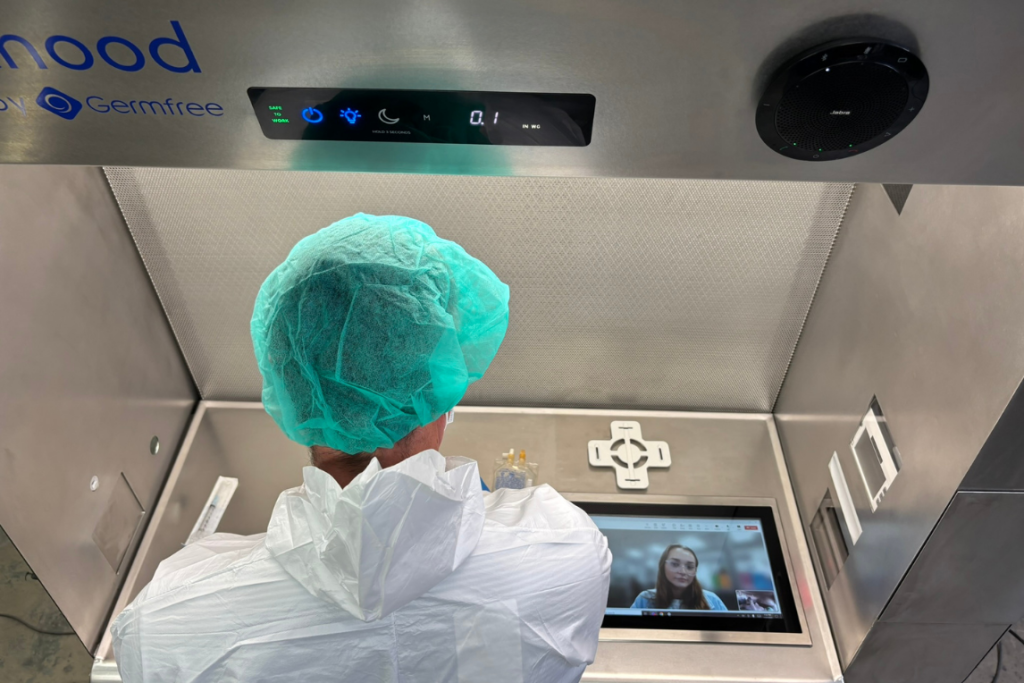Resilient by Design: How Pharma Can Both Scale Like Tech and Deliver Like Logistics
Industry:
Healthcare, Biopharma
Type:
Article
By Luke Rogers at On-Demand Pharmaceuticals and Carol Houts at Germfree
The pharmaceutical industry is facing frequent drug shortages and rising prices. Patients, regardless of geography deserve better, more equitable access to high-quality medicines. As the world demands faster, more resilient, and more cost-effective healthcare systems, the question becomes: why hasn’t pharma learned more from other industries that have already mastered scalability, reproducibility, and customer-centric delivery with a decentralized approach?1

Pharma must embrace lessons from industries where companies have built global networks capable of delivering consistent experiences and products across borders. Can we translate the operational excellence seen in fast food franchises, consumer packaging, or even aerospace manufacturing into pharmaceutical production? We must build a smarter, more agile pharmaceutical supply chain that meets patient needs in real time, without compromising on quality or safety.
We propose a model of pharmaceutical manufacturing that draws on proven methodologies from outside our industry and uses them to reimagine the way we make and deliver medicines.
By integrating distributed manufacturing, standardized kitting, big data, and intelligent automation, we believe the future of pharma can be increased patient access through faster, more efficient, and more reliable processes for everyone.
Point-of-care applications and kitting
Kitting has transformed logistics in other industries, and offers a proven strategy for achieving operational consistency across varied settings.2,3 Companies like IKEA and HelloFresh have mastered the art of distributing standardized kits that produce consistent results in wildly different environments. Despite perceived differences in complexity, pharma can achieve similar reproducibility in drug production.4 Single-use systems and cell and gene therapy workflows have already embraced the early stages of this approach. Now, it’s time to expand and industrialize the model.
Incorporating kitting into pharma at scale opens the door to rapid deployment of modular manufacturing units. Each kit becomes a controlled building block, simplifying training, reducing the margin for error, and minimizing dependency on centralized infrastructure. Critically, well-designed kitting strategies enhance supply chain resilience by allowing for multi-supplier sourcing and eliminating single points of failure. This approach helps prevent production delays and reduces the risk of stockouts, ensuring consistent availability of essential components.
Figure 1 shows a sample pharma kitting process that can links suppliers, facilities, and operators into a harmonized system. It would transform a diverse, multi-supplier supply chain into a replicable, standardized building block, enabling reliable performance at every node in the network.

Figure 1: Kitting for Distributed Manufacturing
First, components such as reagents, excipients, consumables, and disposables are sourced from pre-qualified suppliers based on specifications tailored to the kit’s intended application. Each item is then inspected, serialized and matched against a bill of materials. The components are then assembled into standardized kits in a GMP-compliant kitting facility following validated SOPs. This process includes packaging, labeling and quality checks to ensure every kit is complete, traceable, and compliant. Finalized kits are then queued for distribution to network nodes, where they can be deployed interchangeably without requiring local revalidation, reducing complexity and accelerating readiness.
Standardized processes through technology integration
To successfully build upon the flexibility introduced by kitting, standardized operational models are essential to ensure uniform quality and performance. Borrowing from the franchise systems used in the food industry, pharmaceutical operations can streamline deployments while preserving compliance and reliability.
Chipotle brings new restaurants online in months, not years, with systems thinking, as shown in Figure 2. Each location follows strict procedures, uses similar layouts and tools, and delivers a reliably consistent product. 5,6
Contrast this with traditional pharma manufacturing, where each site is often a bespoke project requiring years of design, construction, validation, and tech transfer. The opportunity here is obvious: if we can build sites that are replicable like franchises, we can dramatically reduce launch timelines and costs.
Done right, it unlocks the potential to clone successful production environments repeatedly, no matter the geography or scale.7

Figure 2: Timeline - Chipotle vs. Pharma Manufacturing
To fully realize this standardization and enhance traceability, advanced technologies must be integrated into every step of the manufacturing process. RFID and machine vision enable real-time oversight, ensuring each component is verified and every action is captured for analysis and accountability.
Hospitals already leverage RFID tagging in crash carts to monitor medication availability in real time, ensuring lifesaving supplies are always in the right place at the right time. 8,9 In pharma manufacturing kits, RFID tags could track components from supplier to end-use, flag inconsistencies, and automate inventory reordering.
Machine vision offers real-time compliance monitoring—ensuring every action by every operator matches protocol, detecting deviations long before they lead to batch failures. Several companies such as Nestle,10 Pepsi,11 and Amazon12 have implemented computer vision tools for enhancing efficiency, compliance, and adherence to safety guidelines. We too can adopt tools for product inspection, label reading, process quality and operator compliance.
Together, these tools reduce manual error, enhance traceability, and create a digital thread of accountability across the entire process. This level of transparency and accuracy equate to a higher-quality product for patients in this new paradigm.
Big data and predictive analytics: driving a data-centric approach
A truly agile, distributed pharmaceutical network cannot operate without a comprehensive, data-centric core.13 Operational awareness across all nodes tracking not just equipment performance but also material movement, production status, and operator behavior is critical not only for patient safety and regulatory compliance but also for proactive supply chain management.14 Companies like Walmart and Amazon have invested heavily in predictive analytics and bid data models.
A well-integrated data infrastructure for them enables predictive inventory management, reducing the risk of product expiration and minimizing waste across the network.15,16 It can help forecast material needs, reroute supplies in response to regional demand, and even automate replenishment processes. Applied to the pharmaceutical industry, machine learning algorithms, fueled by large, high-quality datasets, can serve as early warning systems for impending drug shortages, enabling intervention before patients are affected.15
Standardized kits and harmonized facility design make it possible to move materials and workloads between nodes with minimal disruption—removing the traditional barriers posed by variations in equipment, SOPs, and staff training. In such a system, key performance indicators (KPIs) including rejection rates, customer complaints, recall frequency, and turnaround time can be continuously monitored and benchmarked across the network.16 This enables swift identification of performance anomalies and facilitates ongoing optimization of both processes and resource allocation.
Metrics such as rejection rates and recall frequency provide visibility into what went wrong, but understanding how and why deviations occur requires taking a closer look at the execution of the process itself. We want to embrace Quality by Design (QbD) principles.17 QbD emphasizes that quality should be built into a process from the outset, not tested in at the end. This QbD philosophy will be built into our processes and guaranteed by our MES and machine vision platforms.
The integration of predictive analytics in concert with real-time cross-site visibility under the QbD paradigm is what sets a modern, distributed network apart from traditional manufacturing. These tools lay the foundation for the next critical element: a quality and compliance strategy that is as adaptive, scalable, and intelligent as the network it governs.
Quality assurance and regulatory compliance
While distributed manufacturing offers speed, flexibility, and proximity to patients, it also introduces a broader array of variables that, if left unchecked, can pose serious risks to quality. With multiple sites, multiple operators, and dynamic supply chains, the challenge lies in ensuring that every product meets the same high standard, regardless of where or by whom it was made.
However, this complexity can be managed through the rigorous standardization and system integration we have discussed above. By unifying kit design, facility layouts, equipment, and process workflows, and coupling them with a manufacturing execution system (MES) and advanced machine vision capabilities, we can build a foundation of uniformity. These digital and physical systems together generate structured data that feeds into a distributed quality management system (QMS), providing real-time oversight and traceability across every node of the network.
Maintaining regulatory integrity across a distributed model requires intentional system design and robust oversight mechanisms. Quality management systems must evolve to support decentralized operations while satisfying diverse state and federal requirements.
A distributed network doesn’t mean sacrificing quality or compliance, it means designing for it from the ground up. This starts with a distributed quality management system (QMS) tightly integrated with the manufacturing execution system (MES). By integrating data from multiple nodes, including environmental controls, MES workflows, and inventory status; operators and quality teams can detect early warning signs of disruptions such as drug shortages (e.g., dexmedetomidine) and ensure site-level compliance. The system’s centralized logic enables predictive oversight while preserving local autonomy, reinforcing the critical role of a data-driven QMS in a decentralized model. All can be visualized from a single live dashboard, such as the one in Figure 3.

Figure 3: Distributed Quality Management System (QMS) Dashboard
Each operator follows the same guided workflow. Each sensor feeds into a centralized monitoring system. Each anomaly triggers an immediate response, not a days-later deviation report. Packaging solutions that double as a storage container and an in-process mixing vessel can further simplify the process. Like Nespresso and Keurig pods in a controlled just-add-water approach, shelf-stable packaging will be created and filled at the centralized kitting locations (blue nodes Figure 1) and shipped to respective green nodes, where they will await demand for the medicine. Once demand is triggered, the packaging can then be formulated and translated directly into a patient-ready medicine.
Compliance for a distributed network with this packaging concept must be multi-jurisdictional.18 With oversight from both the FDA and state pharmacy boards, each node must always be audit-ready. This demands real-time data capture, electronic batch records, and a culture that embraces transparency.
Future outlook: sustainability, automation, and rapid deployment
While the distributed model offers compelling advantages in scalability, flexibility, and resilience, it is not without supply, logistics, workforce, and infrastructure challenges. These underscore the need for deliberate system design, robust digital infrastructure, and continuous investment in training and supplier management.
As distributed manufacturing matures, its alignment with sustainability and rapid deployment goals becomes increasingly evident. Innovations in automation, prefabricated infrastructure, and localized production will redefine what is possible in pharmaceutical supply chains. This model also opens doors to faster, more sustainable production. Modular cleanrooms are already available that can be prefabricated and deployed in weeks. Automation and robotics reduce the need for high-intensity labor. Environmental sensors ensure every site meets GMP conditions,18 regardless of climate or location. Perhaps most exciting is the potential to localize production. A network of nimble, tech-enabled manufacturing sites could respond to local outbreaks, address regional drug shortages, or even adapt formulations to community-specific needs, all without waiting on global supply chains.
The pharmaceutical industry can no longer afford to view manufacturing as a fixed, centralized process. In an era that demands agility, responsiveness, and resilience, a new model is emerging; one shaped by lessons from other industries that have mastered scale and consistency. By adopting distributed manufacturing, embracing intelligent kitting, and building a digital backbone of data and automation to serve predictive analytics models,19 we can transform how medicines are made and delivered. This intentional, technology-enabled design turns a potential risk into a strategic advantage, laying the groundwork for resilient, compliant, and continuously improving manufacturing operations at scale.
It’s not just a matter of efficiency—it’s a matter of equity. Because patients everywhere deserve better. And now, we have the tools to deliver it.
Pharmaceutical Manufacturing and Packing Sourcer, Summer 2025, pages 43-47. © Samedan Ltd.
Carol Houts brings nearly three decades of experience in pharmaceutical, biologics product development, quality, regulatory affairs and clinical research. Her extensive background has positioned her as a strategic force within Germfree, an offsite cleanroom construction company providing innovative facility solutions for biopharmaceutical applications. Carol’s career includes executive leadership roles in various full-service clinical research organizations such as QST Consultations (Abond), Clinartis, BioRASI and Pleiad (Cromsource). Her responsibilities spanned across global service management, including clinical operations, regulatory affairs, pharmacovigilance and more.

Luke Rogers, Vice President of Innovation & Product Development at On-Demand Pharmaceuticals, leads a multidisciplinary team focused on transforming how medicines are developed and delivered. His work integrates artificial intelligence, digital platforms, and advanced manufacturing to accelerate the production of high-quality medicines and improve patient access. Originally from Ireland, Luke earned his degree in Medicinal Chemistry and completed his PhD at Trinity College Dublin, Ireland, specializing in the synthesis and biomedical applications of tetrapyrroles.

Resources
- Mascia, S. et al. (2020). “End-to-End Continuous Manufacturing of Pharmaceuticals.” Annual Review of Chemical and Biomolecular Engineering.
- IKEA Supply Chain Strategy, IKEA Annual Sustainability Report (2023).
- Smith, D. (2021). “How Meal-Kit Services Changed the Supply Chain.” Supply Chain Management Review.
- Hellström, D., & Nilsson, F. (2011). “Logistics-Driven Packaging Innovation.” International Journal of Physical Distribution & Logistics Management.
- Chipotle Mexican Grill, Inc. (2023). Annual Report.
- Mena, C., et al. (2014). “Standardization vs Customization in Supply Chain Management.” Journal of Operations Management.
- McKinsey & Company (2021). “Big Data Analytics in Pharmaceutical Manufacturing.”
- Sarac, A., Absi, N., & Dauzère-Pérès, S. (2010). “A Literature Review on the Impact of RFID Technologies on Supply Chain Management.” International Journal of Production Economics.
- GS1 Healthcare (2022). “RFID Implementation for Inventory Management.” GS1 Healthcare Reference Book.
- Nestlé AI Scoop Detection. (2022). Vision Systems Design. https://www.vision-systems.com/factory/consumer-packaged-goods/article/14299012/nestle-automates-inspection-of-plastic-scoops-in-adult-nutrition-products
- Suntory PepsiCo Date Verification. (2023). Insight.tech. https://www.insight.tech/industry/machine-vision-inspection-puts-the-focus-on-quality-control
- Amazon Worker Monitoring with Machine Vision. (2020). Ars Technica. https://arstechnica.com/information-technology/2020/12/amazon-to-roll-out-tools-to-monitor-factory-workers-and-machines
- Capgemini (2022). “Leveraging Big Data for Pharmaceutical Logistics Optimization.”
- Chui, M., Manyika, J., & Miremadi, M. (2018). “What AI Can and Can’t Do (Yet) for Your Business.” Harvard Business Review.
- ISPE (2021). “Pharma 4.0™: Data Integrity by Design.”
- Wang, Y., et al. (2020). “Predictive Analytics in Pharmaceutical Supply Chains.”
- Yu LX, Amidon G, Khan MA, Hoag SW, Polli J, Raju GK, Woodcock J. Understanding pharmaceutical quality by design. AAPS J. 2014 Jul;16(4):771-83.
- WHO (2019). “Good Manufacturing Practices for Pharmaceutical Products.”
- Stank, T. P., et al. (2019). “Predictive Analytics and Supply Chain Performance.” Journal of Business Logistics.
You might also be interested in

Inside Germfree’s Isolator Engineering Process

Why Mobile and Modular Cleanrooms are Changing the Game in Bio-Manufacturing

Smarthood™: Setting a New Standard in IV Compounding
Contact us: Let's unlock your scientific potential together
Complete our contact form and a member of our commercial team will contact you within 24 hours.
